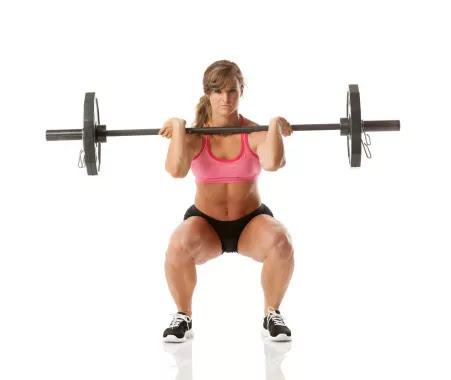Front Squat: Force Your Body To Grow
Back squats may let you lift heavier, yet the front squat will constrain your body to develop. Here's the manner by which to do it appropriately

The back squat is the exemplary lower-body lift. It packs muscle on your glutes, quads, and hamstrings, just as selecting your abs and lower back which must make a solid effort to settle your middle as you lift and lower the bar. It's additionally a compelling quality structure move, which is the reason it's so mainstream with tip-top competitors from 100m runners to UFC warriors to American footballers to swimmers.
Be that as it may, there's another movie you should add to your leg-building exercises in case you're not kidding about adding strong size and solidarity to your lower body: the front squat.
It's a regularly disregarded lift yet one that merits your consideration. While comparative the back squat, it has one key distinction: you hold the bar over the front of your shoulders, at the head of your chest, instead of behind your neck.
This critical change powers your quads, the muscle bunch on the facade of your thighs, to oversee and move a greater amount of the heap, just as making your center muscles work much harder to keep your middle upstanding and your chest area adjusted.
Furthermore, there's a reward, as well. In contrast to the back squat, where it's normal for your structure to endure towards the finish of each set, the position you're in for the front squat powers you to remain upstanding and keep up the right structure, which implies you can crouch all the more securely. Here's all that you have to know.
Instructions to Do the Front Squat
The Set-up
Start with the bar secure in the squat rack, level with the center of your chest. Hold the bar with hands only more extensive than shoulder-width separated. Step in near the bar and lower into a quarter squat so the bar is level and contacting the head of your chest and front of your shoulders. Without relinquishing the bar, bring your elbows advances and up as high as you can oversee. Zero in on keeping your elbows as high as conceivable all through the squat – this will keep your body upstanding and the bar secure in the lawbreaker of your hands and leaning against your chest and shoulders. Drive up to beat the lawyer exam out of the rack.
The Move
Make one stride in reverse. Position your feet shoulder-width separated, with your toes pointing somewhat corner to corner away from one another. Support yourself, take a full breath in to fill your chest and keep your middle solid, at that point twist your legs to bring down into a squat. Keep your knees wide separated and heels down. Lower until your legs are in any event corresponding with the floor, at that point drive back up to stand. That is an impeccable structure. In case you're battling, here are a few different ways to improve.
Front Squat Form Tips
Hand Position
The ideal structure for the front squat can be troublesome because of the restricted adaptability of the wrists and lower arms in case you're not accustomed to it. In the event that that is you, start by warming your wrists up. Interlock your fingers and turn your wrists in the two ways for several minutes. Still an issue? An answer is to get into the position where you're going to lift the bar out of the rack, yet fold your arms and hold the bar against your shoulders. Keeping your shoulders high is as yet a need here. You'll presumably not have the option to lift as much weight so thump the weight plates down until you're agreeable.
Elbows
When you let your elbows drop, the weight will tip advances, pushing you wobbly and flagging the finish of your set. Fix this by zeroing in on pushing your elbows towards the roof all through the move. Additionally, take a stab at uniting your hands or further separated to discover a place that lets you keep your elbows high.

Front Squat Variations
Raised heels front squat
In all squats, lower leg versatility and calf adaptability can be an issue. While you chip away at improving those divisions, you can even now front squat by raising your heels on little weight plates for this move. This can likewise permit you to go further and put more accentuation on your quads for a more prominent turn of events.
Cup squat
In case you don't know about taking on a stacked free weight in a front squat, you can develop to it by utilizing an iron weight or hand weight first. Hold the weight against your chest with your arms twisted so your hands are over your elbows (as though holding a cup in two hands). Drop into a squat until your elbows contact within your knees, at that point drive back up to a standing position. This activity will get you used to hold a load before your body while hunching down and is an incredible leg-strengthener in its own right.
Balance iron weight front squat
This activity goes about as a movement from the cup squat as you develop to the full front squat, and is an incredible method to work out your center all in all. The thought is to put more load on one side of the body, so your center needs to fight the temptation to go to that side as you squat, which enrolls various muscles that those associated with a straight here and there squat. You can do the counterbalance squat with either an iron weight on one shoulder or two portable weights of various loads. Hold the iron weight in the rack position against your shoulder and drop into a squat until your elbow passes within your thigh, at that point push back up, at the same time guaranteeing you oppose any revolution in your middle.
Band-opposed front squat
On the off chance that you choose to lift the weight on the bar isn't sufficient for you, you can include an opposition band. This doesn't simply expand the general opposition engaged with the lift, yet stacks that obstruction towards the head of the move, since that is the place the pressure in the band will be at its most prominent. This implies there's no additional heap on the base aspect of the activity, which could be dangerous given the portability challenge of the squat, however, it expands your capacity and power you to drive as far as possible up as you remain to counter the band's developing obstruction.
To play out this variety, join the obstruction band to a racked bar, keeping the two circles on the bar somewhat more extensive than shoulder-width separated, at that point remain on the opposition band so it's rigid. At that point play out your front squat as should be expected, being mindful so as not to give the additional obstruction access the second 50% of the activity lose your structure.
ORIGINALLY WRITTEN BY:- FITNESS YODHA

